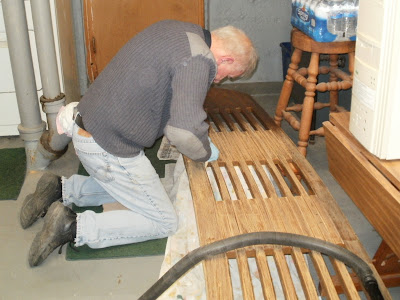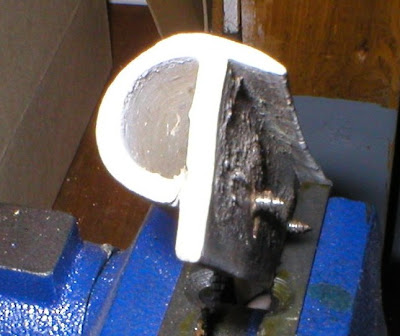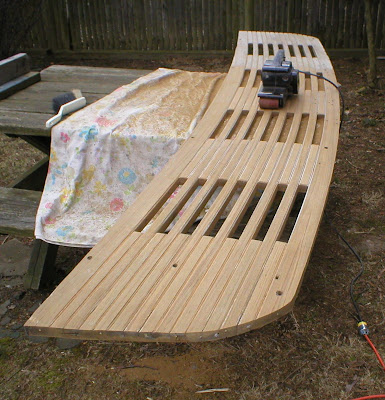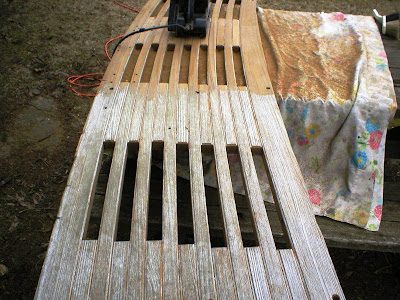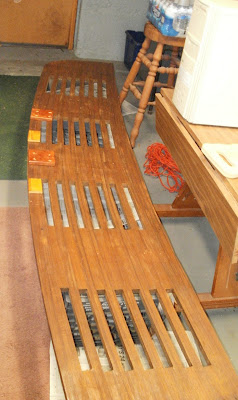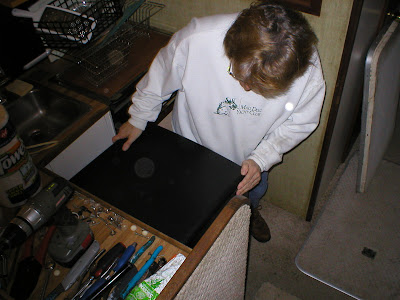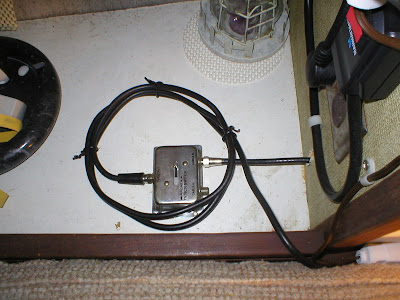This side had really been abused over the years and it certainly wasn't installed by Siliverton. The side that fits against the boat was cut very crudely to fit the curve of the transom, with a few dips here and there. The previous owner drilled numerous holes to mount things and the stainless brackets that hold the platform are after-market, although perfectly acceptable. Sometime in the past this swim platform was also sanded (more than once we'd guess) with a sanding disk and that was done without removing any of the hardware that was bolted to it. As a result, there were many little platforms where something was mounted and lots of nicks, scrapes and gouges. Our belt sander eliminated many of this old damage but not all, since some of the gouges were deeper than we cared to go.
As we saw on the bridge ladder steps, the grain on the teak turned up sharply after the application of the second coat of Sikkens. We hand-sanded the entire surface with 100-grit sandpaper and folded the sandpaper over the 1/8-inch edge of an old piece of molding to sand the grooves that were milled between the teak planks.
Once the sanding was complete, we vacuumed up the debris and then went over the entire surface with our dampened white socks. (You have to be a regular reader of this blog to know exactly what that means.) That took up a lots sawdust that the vacuum didn't catch.
Besides working on the swim platform we also went down to the boat, although on Saturday it seems so cold inside the shed that cleaning our house seemed like a better alternative for the rest of the afternoon. Before we left, we hooked up a 30-amp battery charger to our new inverter batteries. (Boats are supposed to be unplugged from shore power when the owners aren't there but we usually leave the boat plugged in to charge the engine batteries on Saturday and unplug on Sunday before we leave.)
We needed to put a big charger on our two new inverter batteries because, several weeks ago, Bill inadvertently unplugged the boat on Sunday afternoon without first turning the inverter off. I should also mention that I had two 100-watt work lights on and plugged into the inverter outlet in the salon when I left. Usually, once I unplug the boat anything I have left on, goes off. Not this time.
Once I unplugged the boat, the inverter turned on, keeping both work lights going. It stayed that way for six days and when we arrived the next Saturday, we could hear an alarm sounding. The inverter had shut down and both batteries were badly discharged. Once we plugged the boat back in, the inverter began charging the two batteries but with just 10 amps available from the inverter, it would have taken three days or more to bring the batteries back. Since we have to unplug the boat on Sunday when we leave, there wasn't much alternative but to bring down a higher capacity charger on Saturday, connect it to the inverter batteries and leave it on for approximately 18 hours.
That worked as planned. When we arrived on Sunday, both of the inverter batteries were charged and on "float" mode, according to the charger. We reconnected the batteries to the inverter and everything worked as expected. No alarms and the transfer switch in the inverter worked perfectly.
This won't be a problem when the boat is in the water and plugged into the dock power but it was a learning experience. It seems that 200 watts for six days exceeded our designed battery capacity. All we want is to keep the fridge going for an 8-hour boat trip.
If you haven't fallen asleep reading all this detail, then you must love working on boats as much as we do.

